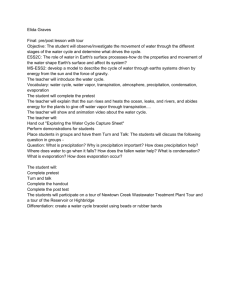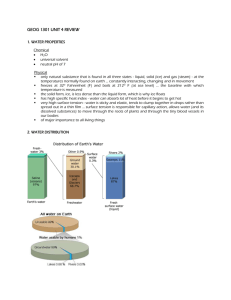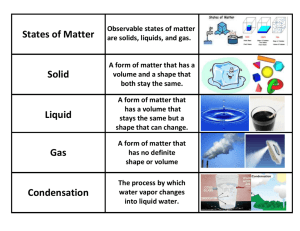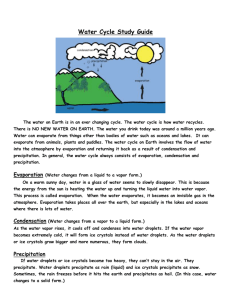Lesson Title: The Water Cycle
advertisement
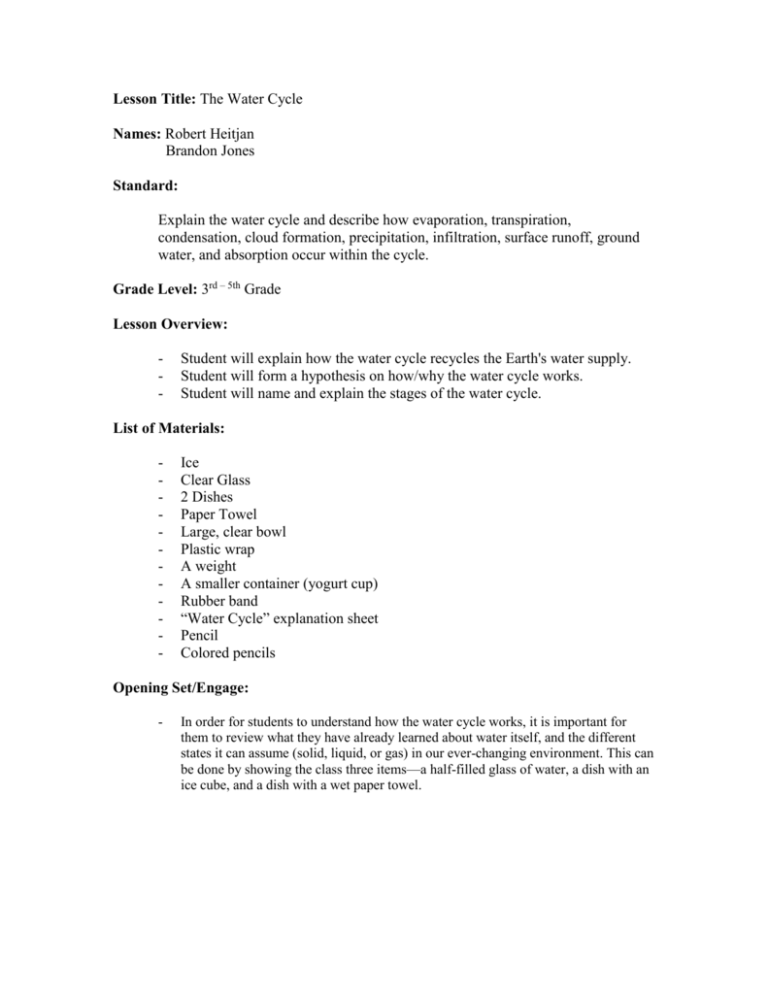
Lesson Title: The Water Cycle Names: Robert Heitjan Brandon Jones Standard: Explain the water cycle and describe how evaporation, transpiration, condensation, cloud formation, precipitation, infiltration, surface runoff, ground water, and absorption occur within the cycle. Grade Level: 3rd – 5th Grade Lesson Overview: - Student will explain how the water cycle recycles the Earth's water supply. Student will form a hypothesis on how/why the water cycle works. Student will name and explain the stages of the water cycle. List of Materials: - Ice Clear Glass 2 Dishes Paper Towel Large, clear bowl Plastic wrap A weight A smaller container (yogurt cup) Rubber band “Water Cycle” explanation sheet Pencil Colored pencils Opening Set/Engage: - In order for students to understand how the water cycle works, it is important for them to review what they have already learned about water itself, and the different states it can assume (solid, liquid, or gas) in our ever-changing environment. This can be done by showing the class three items—a half-filled glass of water, a dish with an ice cube, and a dish with a wet paper towel. - Begin by drawing attention to the glass of water. Ask questions such as: What is in this glass? What is water? What does it look or feel like? Is water a solid, a liquid, or a gas? Where can you find water? Where does it come from? - Guide the class in establishing that water is a liquid that both falls from the sky in the form of rain and can be found in abundance in oceans, lakes, streams, and underground. Next, pick up the dish with the ice cube and show it to the class. Ask questions such as these: What is in this dish? Describe ice. What does it look or feel like? Is ice a solid, a liquid, or a gas? What is ice made of? How is it made? If I left the ice in the room for a few hours, what would happen to it? - Help the class to see that ice is water that has been frozen into a solid because it has been exposed to very low temperatures. Make sure they understand that when ice is allowed to warm up, it returns to liquid water. Next, present the dish with the wet paper towel, asking questions like these: What is this? What would happen if I left it out for a few hours? Why would it dry out? Besides paper towels, what are some other examples of wet things that dry out over time? (Examples could include wet clothes, watered plants, glasses of water, and puddles.) What if I put this wet paper towel outside during the winter? What might happen to it? Why? - At this point, students should understand that when water is exposed to warm temperatures, it disappears or evaporates, becoming a gas, while under colder conditions it can freeze into ice, becoming a solid. It is important to emphasize that the three water samples they've seen represent the three states, or forms, that water takes on as temperature and other conditions change. Exploring the Topic: - To help students better understand the constant circulation and transformation of water in the outside world—the water cycles—have them think about and discuss questions such as these: Where does water go when it disappears or evaporates? What role does the sun play in the evaporation process? Where does water come from when it rains? How are clouds formed? When rain (snow/sleet) falls to the ground, what usually happens to it? (Accept all reasonable answers. Encourage students to elaborate on their responses.) - Using their Water Cycle student E-Sheets, students should visit Round & Round It Goes, The Water Cycle to learn more about how the water cycle works. Students will be directed to click on and read each process of the water cycle as shown on the graphic—starting with precipitation and ending with water vapor—and answer questions and take notes using their “Round and Round It Goes!” student sheets. When finished, discuss with them what they have learned and be sure to emphasize key benchmark concepts involving both the transformative (liquid/solid/gas) and the continuous, cyclical aspects of the global water cycle process. - Next, divide the class into groups, depending on the availability of your resources. To better apply and reinforce what they have learned, have each group complete the hands-on activity on the Model Water Cycle student sheet. Each group will be asked to create a model of a water cycle in class. Among other things, they will be able to observe how water condenses and then precipitates. Once the models are completed and the changes within them start taking place, include in your discussion questions such as these: Describe what is happening in your miniature water cycle. What effect is the sun having on your water cycle? The shade? What caused the water to evaporate in the mug or "ocean"? Where did the water go? How can you explain what is taking place on the plastic wrap? How can you explain the dripping that is taking place? Explain the processes involved in the water cycle that took place inside your models. Assessment: - Divide the class into seven groups with each one representing one of the key processes in the water cycle—precipitation, infiltration, ground water, water table, evaporation, transpiration, and water vapor. Hand out poster paper and crayons or markers, and have each group draw a picture showing how their process works within the water cycle. Instruct them to use their notes and previous websites as resources. When they have finished, have the teams arrange their posters on the wall in the correct order, starting with precipitation. Ask each team to explain how their process works. After their presentations, encourage a class discussion, supported by their water cycle models or real-world examples. References: http://www.kidzone.ws/water/ http://www.sciencenetlinks.com/Esheet.cfm?DocID=102 Round and Round It Goes! Name:____________________________ Use this student sheet to answer questions and take notes based on what you read about each process of the water cycle on the Round & Round It Goes! The Water Cycle website: (http://www.dnr.state.wi.us/org/caer/ce/eek/earth/groundwater/watercycle.htm). Rain & Snow (Precipitation) What is precipitation? ________________________________________________________________________ ________________________________________________________________________ ________________________________________________________________________ __________________ What happens to precipitation when it falls over Michigan ? ________________________________________________________________________ ________________________________________________________________________ ________________________________________________________________________ __________________ Other notes on precipitation: ________________________________________________________________________ ________________________________________________________________________ ________________________________________________________________________ __________________ Infiltration What is infiltration? ________________________________________________________________________ ________________________________________________________________________ ________________________________________________________________________ __________________ How are plants a part of this process? ________________________________________________________________ ________________________________________________________________ _________________________ Other notes on infiltration: ________________________________________________________________________ ________________________________________________________________________ ________________________________________________ Ground Water What is ground water? ________________________________________________________________________ ________________________________________________________________________ ____________________________________________ Describe the movement of ground water. ________________________________________________________________________ ________________________________________________________________________ ________________________________________________________________________ ____ Other notes on ground water: ________________________________________________________________________ ________________________________________________________________________ ________________________________________________________________________ __________________ Water Table What is the water table? ________________________________________________________________________ ________________________________________________________________________ ________________________________________________________________________ __________________ Other notes on water tables: ________________________________________________________________________ ________________________________________________________________________ ________________________________________________________________________ _________________ Evaporation What is evaporation? ________________________________________________________________________ ________________________________________________________________________ ________________________________________________________________________ __________________ Other notes on evaporation: ________________________________________________________________________ ________________________________________________________________________ ________________________________________________________________________ __________________ Transpiration What is transpiration? ________________________________________________________________________ ________________________________________________________________________ ________________________________________________________________________ __________________ What happens to water vapor once it is let into the atmosphere? ________________________________________________________________________ ________________________________________________________________________ ________________________________________________________________________ __________________ Other notes on transpiration: ________________________________________________________________________ ________________________________________________________________________ ________________________________________________________________________ _________________ Water Vapor What is water vapor? ________________________________________________________________________ ________________________________________________________________________ ________________________________________________________________________ __________________ What causes clouds to form? What causes precipitation to fall? ________________________________________________________________________ ________________________________________________________________________ ________________________________________________________________________ ___________________ Other notes on water vapor: ________________________________________________________________________ ________________________________________________________________________ ___________________ Model Water Cycle Name:____________________________ Materials • A large metal or plastic bowl • A pitcher or bucket • A sheet of clear plastic wrap • A dry ceramic mug (like a coffee mug) • A long piece of string or large rubber band • Water Directions 1. Put the bowl in a sunny place outside, on a windowsill, or on a table under a window. 2. Using the pitcher or bucket, pour water into the bowl until it is about ¼ full. 3. Place the mug in the center of the bowl. Be careful not to splash any water into it. 4. Cover the top of the bowl tightly with the plastic wrap. 5. Tie the string/or rubber band around the bowl to hold the plastic wrap in place. 6. Observe the bowl as it is now and write down your observations below. 7. Let the bowl sit in the sun for a couple of hours and then observe it again to see what has happened. Observations of bowl before it sit in sun. ________________________________________________________________________ ________________________________________________________________________ ________________________________________________________________________ ________________________________________________________________________ ________________________ Observations of bowl after it sit in sun. ________________________________________________________________________ ________________________________________________________________________ ________________________________________________________________________ ________________________________________________________________________ ________________________
